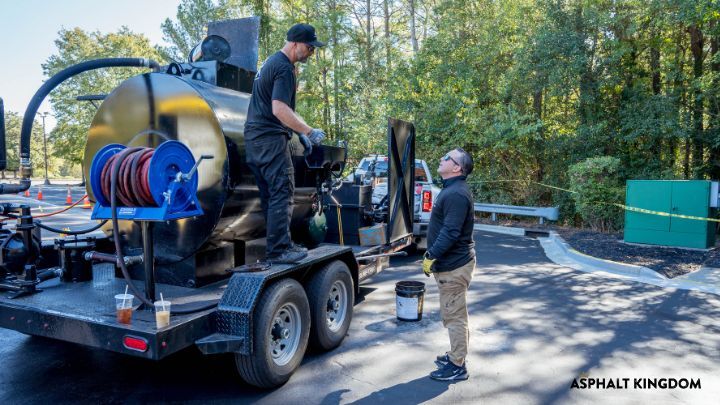When you manage a commercial property, your parking lot or paved surfaces are more than just a place to park cars — they’re an investment. They are the first impression visitors get of your business. But more importantly, they help keep your customers, tenants, and staff safe. That’s why asphalt maintenance should never be an afterthought.
Over time, weather, heavy traffic, and general wear and tear can break down your pavement. But how you handle repairs and upkeep can make the difference between a safe, long-lasting surface and an expensive headache. In this article, we’ll break down how to manage your asphalt proactively, and what to do if you need reactive repairs after storms or harsh weather.
Table of Contents
- Why Asphalt Maintenance Matters
- Understanding Proactive vs. Reactive Asphalt Maintenance
- What Happens After a Storm?
- The Benefits of a Proactive Pavement Asset Management Plan
- Asphalt Maintenance is Simpler Than You Think
- Your Next Step: Get a Free Pavement Assessment
- The Bottom Line: Don’t Wait for Pavement Failure
Why Asphalt Maintenance Matters
Neglecting your asphalt can cost you big money down the road. Cracks, potholes, and depressions don’t just look bad — they can damage vehicles, cause slip-and-fall accidents, and even lead to liability claims. Beyond safety, broken pavement hurts your business’s curb appeal and can discourage customers from visiting.
A well-maintained parking lot or driveway projects professionalism and care, while also extending the lifespan of your surface, saving you thousands of dollars in costly repairs or replacements. Asphalt maintenance is really an investment that pays off over time.
Understanding Proactive vs. Reactive Asphalt Maintenance
You’ll hear the terms proactive and reactive maintenance tossed around in the asphalt industry. Here’s what they mean, in simple terms:
- Proactive maintenance is planned work you do on a regular basis to protect your pavement. Think of it like an oil change for your car — you don’t wait until the engine fails. Instead, you seal cracks, fill potholes early, and apply sealcoat every couple of years to protect the surface from water, oil, and sun damage.
- Reactive maintenance happens when the damage is already there, and you need to fix it fast. A great example is after a big storm, flood, or harsh winter when water has seeped into unsealed cracks, eroding the foundation. That leads to potholes, soft spots, and depressions that pose serious safety hazards.
Reactive repairs are often more expensive and time-consuming because you’re playing catch-up. That’s why property owners are encouraged to jump on problems quickly and then build a long-term proactive plan.
What Happens After a Storm?
-1.jpg?width=720&height=405&name=Blog%20Images%20(33)-1.jpg)
Let’s face it: Mother Nature can be brutal on asphalt. Over the last few years, we’ve seen major storms and floods across the U.S. and Canada. When water gets into cracks that are open and unsealed, it seeps down and weakens the base layers of the pavement. When the base fails, potholes and sinkholes follow.
After any significant weather event, it’s important to assess your parking lot or driveway right away. Look for cracks, potholes, or other damage that could get worse over time. These reactive repairs need to be handled quickly so you can shift back into a proactive maintenance routine.
The Benefits of a Proactive Pavement Asset Management Plan
-1.jpg?width=720&height=405&name=Blog%20Images%20(35)-1.jpg)
Think of proactive asphalt maintenance as a smart business move, not an expense. By routinely inspecting your paved surfaces and taking care of small issues before they grow, you can:
- Extend the life of your parking lot by years
- Avoid expensive large-scale repairs
- Maintain strong curb appeal
- Protect customers and tenants from tripping hazards
- Improve the overall safety of your property
- Keep money in your budget for other priorities
When a parking lot is freshly sealcoated, clean, and free of cracks, it becomes a showcase for your property. Customers notice. Tenants appreciate it. And you rest easy knowing you’ve protected one of your biggest assets.
Asphalt Maintenance is Simpler Than You Think
If you’ve been intimidated by asphalt maintenance, you’re not alone. But the truth is, it’s not rocket science. The right tools and know-how can make it about as easy as mowing a lawn or pressure washing a patio.
For example, filling cracks can be done with a crack-filler machine or even by hand with pourable crack sealant. Sealcoating can be applied with a sprayer or squeegee. These are skills you or your maintenance team can pick up quickly with some training and the right products.
You don’t need to be a pavement engineer to protect your investment. You just need a plan — and the willingness to get started.
Your Next Step: Get a Free Pavement Assessment
To help you get on the right track with asphalt maintenance, we’re offering a free pavement assessment. Here’s how it works:
- Take this free pavement assessment.
- You’ll receive a detailed action plan showing you exactly what equipment, materials, and methods are needed to repair, seal, or maintain your asphalt surface.
This assessment gives you the confidence to budget, plan, and execute maintenance without wasting time or money. Whether you’re dealing with reactive repairs from a recent storm or want to get proactive to extend your asphalt’s lifespan, this is the perfect first step.
The Bottom Line: Don’t Wait for Pavement Failure
Letting cracks, potholes, and other problems sit will only make them worse — and more expensive to fix. Asphalt maintenance is your best defense against the wear and tear that comes from storms, heavy vehicles, and daily use.
By balancing reactive repairs when necessary with a proactive maintenance plan, you can keep your property looking great, safe for everyone, and easier on your budget.
Remember: A clean, smooth, freshly maintained parking lot isn’t just functional — it’s a showpiece for your business. It tells your customers you care about their safety and your reputation.
Ready to protect your pavement? Get your free pavement assessment today and find out how easy asphalt maintenance can be. Your parking lot deserves to look great and stay safe, year after year.
-1.jpg?width=720&height=405&name=Blog%20Images%20(31)-1.jpg)





-2.jpg)